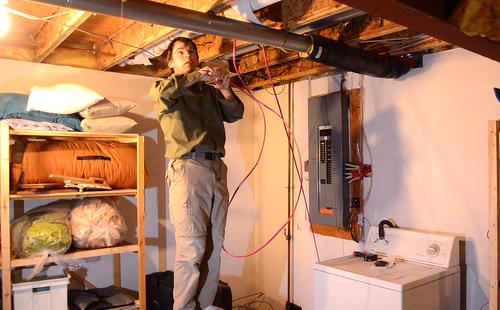 I moved my old table saw into the basement,
along with my old 18" bandsaw.
Both are wired for 240 volts, so rather than rewire the machines
for 120 volt, I figured I'd install a 240 volt circuit.
I moved my old table saw into the basement,
along with my old 18" bandsaw.
Both are wired for 240 volts, so rather than rewire the machines
for 120 volt, I figured I'd install a 240 volt circuit.
 I moved my old table saw into the basement,
along with my old 18" bandsaw.
Both are wired for 240 volts, so rather than rewire the machines
for 120 volt, I figured I'd install a 240 volt circuit.
I moved my old table saw into the basement,
along with my old 18" bandsaw.
Both are wired for 240 volts, so rather than rewire the machines
for 120 volt, I figured I'd install a 240 volt circuit.
I started by snaking some red #12 Romex wire from the breaker panel through the joists to where I needed them to go.
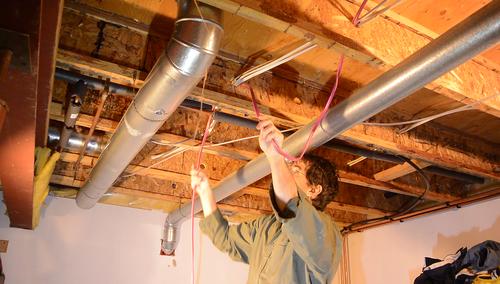 Even though the joists have pre-drilled holes in them, snaking 20m of wire through
all the corners and such was a lot of work. I should have started in the middle
and pulled it towards either end.
Even though the joists have pre-drilled holes in them, snaking 20m of wire through
all the corners and such was a lot of work. I should have started in the middle
and pulled it towards either end.
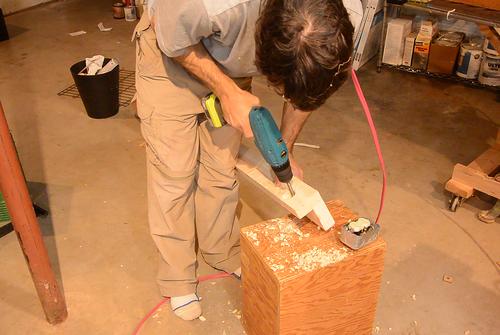 I wanted to put a socket at the base of a steel post in the basement. To have
a place to mount the socket and run the wire, I made an L-shaped rail out of two
2x4s. This will give me a place to screw the socket to and hide the wire.
I wanted to put a socket at the base of a steel post in the basement. To have
a place to mount the socket and run the wire, I made an L-shaped rail out of two
2x4s. This will give me a place to screw the socket to and hide the wire.
Here I'm drilling a hole for where the wire goes through.
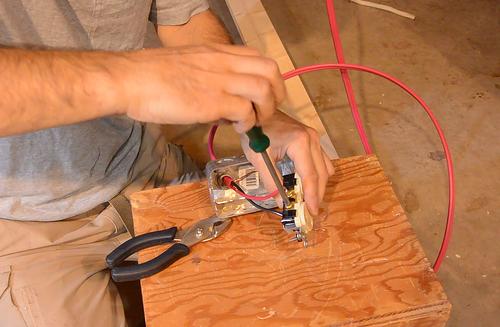 The red Romex wire is normally used for heating. It has black
and a red colored wires instead of black and white. White always indicates "neutral",
but with this 240 volt circuit, both sides are "hot". The red is usually used
to indicate the "other hot phase". The red wire really doesn't differ from normal
white Romex cable other than by colour.
The red Romex wire is normally used for heating. It has black
and a red colored wires instead of black and white. White always indicates "neutral",
but with this 240 volt circuit, both sides are "hot". The red is usually used
to indicate the "other hot phase". The red wire really doesn't differ from normal
white Romex cable other than by colour.
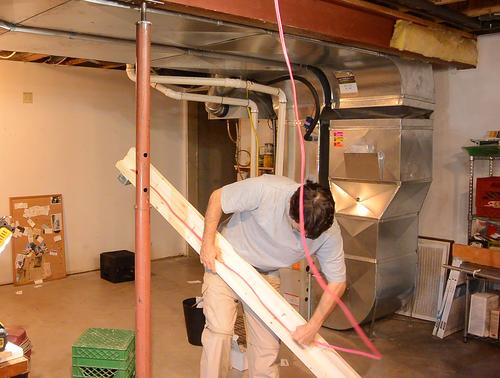 Running the wire along the inside of the L before fixing the L to the post.
Running the wire along the inside of the L before fixing the L to the post.
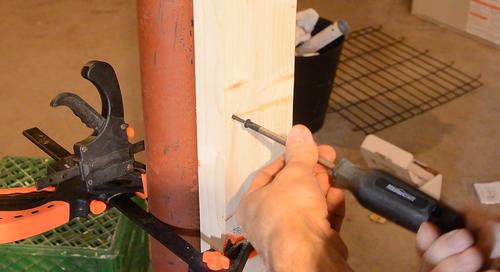 I screwed the L-rail onto the metal post with some drywall screws.
I drilled a hole slightly smaller than the major diameter of the screw in the post.
The drywall screw is harder than the post, so as long as the hole is
only slightly smaller than the screw, it will cut threads into the metal.
I screwed the L-rail onto the metal post with some drywall screws.
I drilled a hole slightly smaller than the major diameter of the screw in the post.
The drywall screw is harder than the post, so as long as the hole is
only slightly smaller than the screw, it will cut threads into the metal.
And heck, with cutting machine screw threads in wood, why not use wood screws in metal? :)
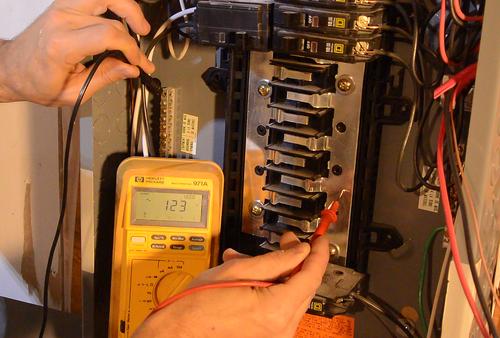
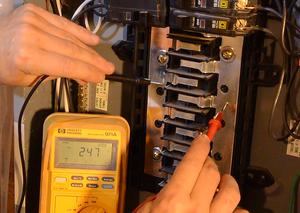 One thing that gets some people confused is where do I get the 240 volts from
if our mains are 120 volts?
One thing that gets some people confused is where do I get the 240 volts from
if our mains are 120 volts?
But a normal hookup here consists of two opposite phases. Each phase is 120 volts from ground, but between them is 240 volts. Two phase is not to be confused with three phase. Two phase is still "single phase" (terminology is confusing) because the two are just opposites of each other, so effectively still one phase. However three phase has three AC waveforms 120 degrees of a cycle separated from each other. Confused? Go look it up on wikipedia.
Note that the meter reads 123 and 247 volts. There is an allowable range of voltages. 117 volts is typical. 123 volts is a bit high but still within tolerance.
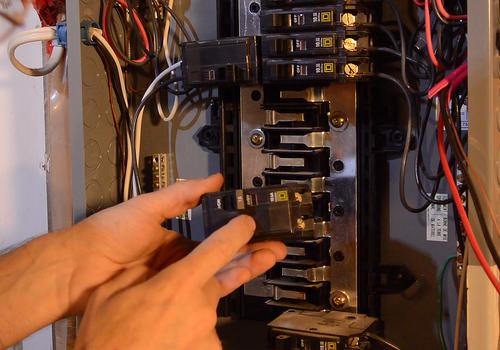 The 240 volt breaker is double width, so it connects to the bars coming
from either side. Basically, it switches both opposite 120 volt phases.
The 240 volt breaker is double width, so it connects to the bars coming
from either side. Basically, it switches both opposite 120 volt phases.
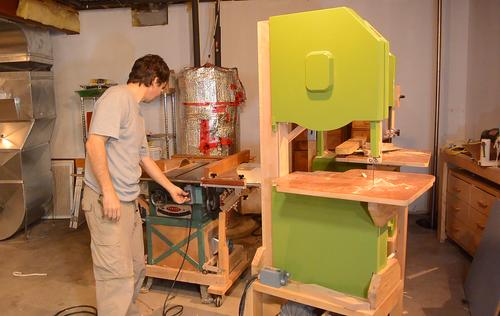
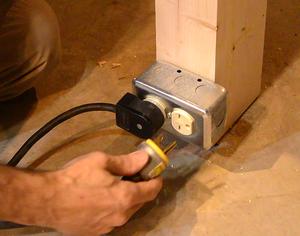 With the 240-volt circuit installed, I can now run my 240 volt machines
in the basement. Yay!
With the 240-volt circuit installed, I can now run my 240 volt machines
in the basement. Yay!
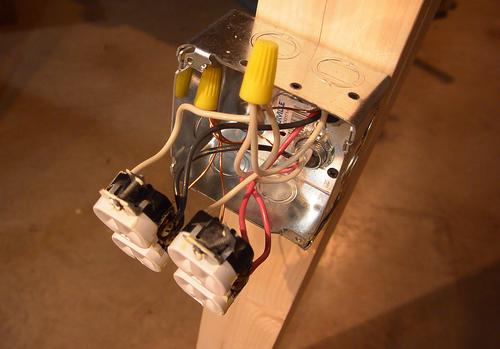 After this, I added more 120 volt sockets to the post on a split 240 volt circuit.
The two sockets shown here share a white neutral wire. The right one is on the red
"hot" wire, the left on the black "hot". They share the white neutral wire.
The shared neutral never gets overloaded because if both sides are loaded, the current
through the neutral actually cancels out.
After this, I added more 120 volt sockets to the post on a split 240 volt circuit.
The two sockets shown here share a white neutral wire. The right one is on the red
"hot" wire, the left on the black "hot". They share the white neutral wire.
The shared neutral never gets overloaded because if both sides are loaded, the current
through the neutral actually cancels out.
I figure I'll eventually have things set up enough in the basement that I can do simple projects down there. That way, if the kids are going nuts, I can hear it and come upstairs and help.
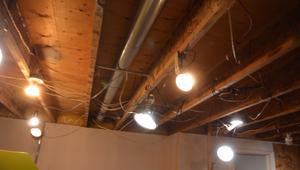 There is a mess of extension cords and lamps on the ceiling right now.
With incandescent bulbs, this might be a safety hazard, but with
LED bulbs at 8 watts each, all the lights together consume about 100 watts,
nowhere near the capacity of the wiring! I'll put up better light fixtures
after adding some sound insulation between ceiling joists.
There is a mess of extension cords and lamps on the ceiling right now.
With incandescent bulbs, this might be a safety hazard, but with
LED bulbs at 8 watts each, all the lights together consume about 100 watts,
nowhere near the capacity of the wiring! I'll put up better light fixtures
after adding some sound insulation between ceiling joists.
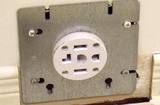 240 volt from dryer plug (for Euro-washer
240 volt from dryer plug (for Euro-washer